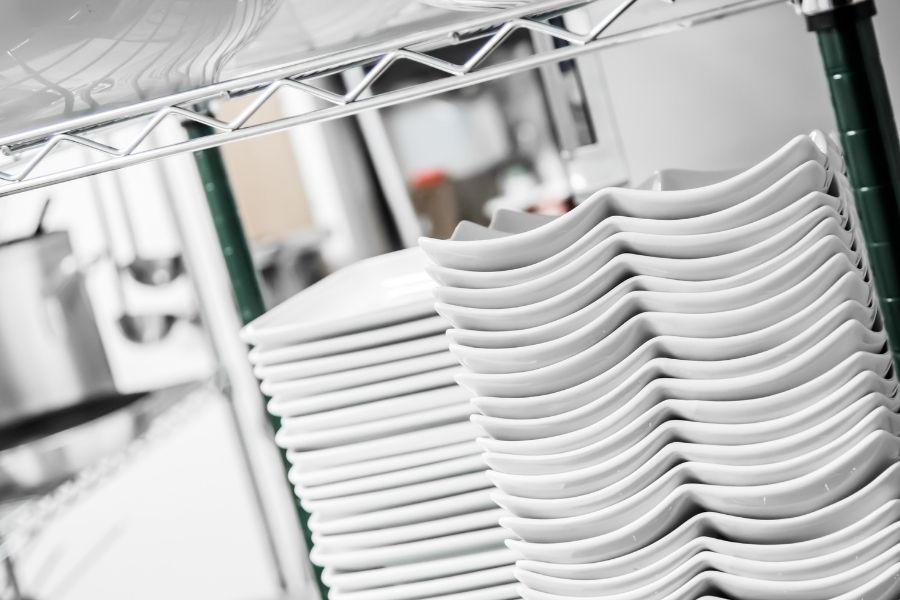What is Ware Washing & What’s Involved?

In a restaurant, hospitality establishment, cafeteria, and other commercial setting where food is served, workers need to have a study supply of plates, glasses, utensils, pots, and other cookware. Washing these items one at a time when serving lots of people creates inefficient processes. In the food service industry, companies rely on ware washing equipment to ensure every item becomes cleaned and ready for use. Learn more about what ware washing is and how the process works.
What is Ware Washing?
The term ware washing involves the method of cleaning and sanitizing any kitchenware that workers use to store food, prepare food, and serve meals. It is normally applied to any commercial business involved with food service, including industries that may have kitchen settings that serve many people at once during short-term or long-term arrangements, such as kitchens and cafeterias in hospitals, schools, nursing homes, and other settings.
The process of ware washing is applied to any item considered "ware," such as dishware, cookware, glassware, and other items. There are two methods involved with ware washing: manual washing and automatic washing. Also, ware washing involves cleaning and sanitizing methods.
Many commercial establishments rely on both manual and automatic means to clean so much kitchenware at once. Automatic ware washing professional equipment focuses on cleaning glasses, utensils, plates, and other small cookware in various ways. Manual washing is used when cleaning and sanitizing cookware that may be too large to fit into automatic equipment. Companies may also resort to manual washing for any items that are too delicate to be cleaned in automatic machines or may cookware that requires special cleaning methods.
Manual Washing
Keep in mind that ware washing methods involve both cleaning and sanitizing. These two processes differ significantly from the other. Cleaning methods involve removing all particulate matter from the surface of kitchenware. Detergent products to use for cleaning vary significantly and are much more available for commercial establishments. Commercial detergents may also have greater concentrations, especially those used with automatic cleaning equipment. The use of gloves is often recommended for this method. Kitchenware may go through a preliminary soaking to loosen up particulates and any residues that may become difficult to remove.
Sanitizing is performed after the dedicated rinsing once washing the kitchenware using detergent. Commercial establishments may use products that are quaternary ammonium compounds (quats) or bleach-based solutions. The sanitizer is used to kill off bacteria, fungi, and viruses that remain on kitchenware after the cleaning processes. It removes the germs until reaching safe levels.
Automatic Washing
Automatic washing equipment varies based on the size of the operations and the setup of the kitchen and cleaning areas. Some establishments may simply use a dishwasher for cleaning. The dishwasher may consist of a door type or a rack type configuration. Dishes are loaded into the machine as either low temperature water or high temperature water is used. A typical commercial dishwasher may clean anywhere from 30 racks to 350 racks of dishes in a day.
Other commercial operations use automatic washing machines. These types of professional ware washing equipment may clean from 350 racks to 1000 racks of dishes a day. Automatic ware washing equipment may come in low water temperature or high water temperature models. Low water temperature models clean the kitchenware while relying on a chemical bath to sanitize the dishes, glasses, and other cooking utensils. High water temperature models contain an internal heater that can get water temperatures up to 180°F. This high water temperature equipment can sanitize the dishes without the additional use of chemical baths.
Ware Washing Equipment
Used in high-volume food service operations, there are various design configurations for automatic machines such as conveyor belt dishwashers, under-the-counter models, tunnel machines, and upright dishwashers. These machines have microprocessors allowing workers to easily control settings based on the types of kitchenware being cleaned at specific times.
For cleaning dishware, pipes are installed in the machines that have flat spray nozzles pressed into the pipes. These flat nozzles send a spray out that is used to remove any remaining detergent or suds from kitchenware during the rinsing stage. Flat nozzles, such as the equipment provided by Lechler, are used in the downstream process during the ware washing cycle that can be used in cleaning oven racks to spray detergent and rinse water onto racks used in bakeries. The flat nozzles may also be used in conveyor belt type machines to remove suds while maintaining an optimal rinsing pressure during numerous washing cycles.
Lechler: Ware Washing Equipment
The type of ware washing equipment used by a company should be based on the types of dishes and cookware that commonly need cleaning and sanitizing, the amount of space available for the equipment, and the kitchen setup. Some companies may only require a standing dishwasher to clean oven racks used when creating cakes and pastries for a bakery. Other establishments may need a conveyor rack system for washing food trays such as ones used in a school or college setting. Whichever model you decide on, you have to consider how the detergent and rinse water is applied to the dishes in the most efficient manner that allows all dishes to be thoroughly cleaned while also helping to minimize water and energy costs.
Here at Lechler, we provide spray nozzles for effective cleaning and rinsing processes within professional ware washing equipment. These nozzles are pressed into pipes or attached using an eyelet clamp and retaining nut. With these spray nozzles, commercial organizations may clean and rinse their kitchenware efficiently whether for large or small operations. These nozzles may be used for a range of ware washing equipment models, including conveyor belt and tunnel machines. For more information regarding our spray nozzle technology, contact Lechler today.